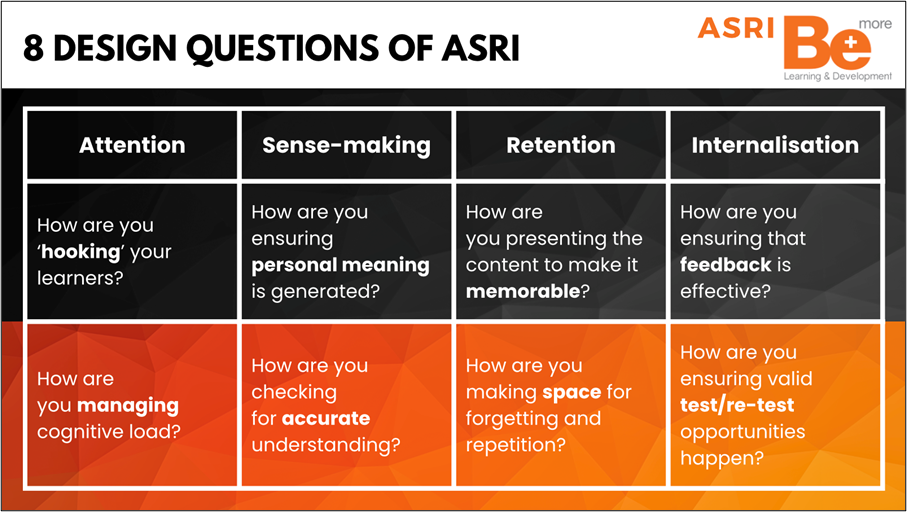The Complexity of Learning
In Learning and Development, particularly in the fast-moving corporate world, the challenges of creating effective learning experiences can feel overwhelming – and can be described as “wicked problems.” Originally defined by Rittel and Webber (1973), a wicked problem has several key features that make it difficult to solve. It’s also hard to describe due to its many complex, hidden components, and each individual may understand the problem in different ways.
Moreover, because these wicked problems are often unique to a given context, having predictable outcomes to any solution is incredibly difficult, and sometimes solving one part of the problem can lead to unintended consequences elsewhere.
Learning is therefore, a wicked problem. Each learner comes with unique motivations, prior knowledge, and experiences environmental influences. Different stakeholders – learners, trainers, and business leaders – often have varied perspectives on what successful learning looks like. And when you attempt to “solve” learning challenges with a one-size-fits-all approach, you can easily create new issues, such as disengagement or knowledge gaps.
Introducing ASRI: A framework for learning design
This is where ASRI, our evidence-based model for learning design and delivery, comes into play. ASRI offers a framework to help L&D professionals ‘tame the wickedness’ by providing a structured, yet flexible, approach to designing learning experiences.
By focusing on four critical components – Attention, Sense Making, Retention, and Internalisation – ASRI helps you mitigate the unpredictable nature of learning and anticipate some of the challenges that arise when designing and delivering training in corporate settings.
ASRI doesn’t simplify the complexity of learning, but it makes the science behind it more accessible, allowing L&D practitioners to make informed, strategic decisions that improve the effectiveness of their training initiatives. Through a thoughtful application of trusted theories, ASRI ensures that learning experiences are designed with intentionality, reducing the likelihood of unexpected consequences and increasing the chances that real, meaningful learning will take place.
ASRI is not just another learning model but a practical guide for decision-making in corporate learning design and delivery.
The four components of ASRI are:
- A is for Attention – what you don’t pay attention to, you can’t learn
- S is for Sense Making – what you don’t understand accurately you can’t use as intended
- R is for Retention – what you don’t recall will decay
- I is for Internalisation – what you can’t apply does not become part of your reality
Why Should Corporate L&D Use ASRI?
As corporate trainers and learning designers, we’re often asked, “When is training good enough?” The ASRI framework helps answer that question by ensuring that learning not only takes place but is impactful. It is rooted in cognitive psychology, adult learning theory, and practical applications that work within the fast-paced world of business.
Here’s how the ASRI framework can transform corporate training experiences:
1: Attention: Capturing focus amidst distractions
In a corporate setting, employees are bombarded with distractions – emails, meetings, and daily demands. Engaging them from the start of any training is critical. Our first challenge is capturing attention.
Key design questions:
- How are you hooking your learners into the material?
- Are you managing their cognitive load effectively?
Tactics:
- Make the learning personally relevant by linking content to employees’ goals and motivations.
- Use multimedia and real-life examples to maintain engagement.
- Allow mental breaks and use micro-learning to avoid overwhelm.
Theories to apply:
- Self-determination theory (Ryan & Deci, 2000) suggests that motivation increases when learners feel autonomous, competent, and related to the material.
- Cognitive Load Theory, developed by John Sweller (1988), explains how the brain processes information and the limits of working memory.
2: Sense Making: Ensuring understanding for real-world application
Every learner interprets new information through the lens of their personal experience. This is especially true in diverse corporate environments. As trainers, we need to ensure that learners not only receive the information but also understand and interpret it correctly.
Key design questions:
- How are you ensuring the training feels personally relevant to each learner?
- How are you checking that employees have accurately understood the material?
Tactics:
- Include reflective questions that ask employees to relate the content to their own experiences.
- Use interactive activities like simulations, role plays or quizzes to check for understanding in real-time.
Theories to apply:
- Theory of perception – “perception – extracting meaningful information from the environment to guide actions adaptively – improves with experience,” (Adolf & Kretch, 2015)
- Schema theory helps explain how connecting new knowledge with existing knowledge can facilitate better learning.
3: Retention: Ensuring long-term knowledge retention
In the fast-paced corporate world, we often deal with the challenge of forgetting. Employees may engage in training but lose key information over time. Our job is to make learning stick.
Key design questions:
- How are you making content memorable?
- How are you making space for forgetting and repetition?
Tactics:
- Use storytelling, metaphors, and other memory aids to help information stick.
- Build in opportunities for spaced repetition and revisit critical concepts regularly.
Theories to apply:
- Memory models emphasize encoding, storage, and retrieval strategies to improve retention (Atkinson & Shiffrin, 1977).
- Forgetting and trace decay theory “…all memories fade automatically as a function of time…forgetting is a default process in the brain” (Davis & Zhong, 2017)
4: Internalisation: Moving beyond knowledge to action
Corporate learning is typically more than just knowledge transfer – it’s about behaviour change. Employees need to use what they learn ‘on the job’, and this requires both practice and feedback to ensure accurate application
Key design questions:
- How are you providing opportunities for practice in real-world contexts?
- How are you ensuring feedback leads to growth and behaviour change?
Tactics:
- Incorporate real-world scenarios, case studies, and projects where employees can practise and apply what they’ve learned.
- Use structured feedback loops, encouraging learners to reflect on their progress, recognise high performance and adjust their approach.
Theories to apply:
- Self-directed Learner (and reflexivity) – “…becoming aware of and managing one’s own process of learning” (Wehmeyer et al, 2000)
- Deliberate practice involves focused, structured practice aimed at improving performance over time (Ericsson & Harwell 2019).

ASRI in Practice: Proven Success
ASRI has been successfully applied in a variety of contexts, most notably with the World Anti-Doping Agency (WADA), where it was integrated into their Global Learning and Development Framework (GLDF). Recently, we worked with 14 trainers from WADA and various National Anti-Doping Organizations (NADOs) at a “Train the Trainer” event in Warsaw, Poland. The goal was to equip these trainers with knowledge of the ASRI model and its application to improve the effectiveness of anti-doping education worldwide. The results/feedback were striking:
- 90% of participants reported knowing significantly more about applying the science of learning.
- 67% increase in trainer confidence, with 90% feeling fully or very confident in their educator roles post-training.
- 70% of participants said they would definitely apply the ASRI principles beyond the training context.
Several key takeaways from the event emphasized the value of ASRI. Participants noted how ASRI’s focus on ‘Sense-Making’ and ‘Retention’ helped them understand how to make their training more memorable and engaging for learners. Trainers appreciated the shift from simply delivering content to facilitating learning, allowing them to better engage learners and ensure they not only absorb information but also apply it effectively in real-world contexts.
This success with WADA underscores the adaptability and effectiveness of the ASRI model in corporate and organisational settings, demonstrating how it can transform learning from a passive process into one that drives real behaviour change. By applying ASRI’s structured approach, L&D professionals can be more intentional about their learning design, ultimately increasing the likelihood of meaningful, long-lasting impact.
In Closing
As L&D professionals, it’s important to acknowledge that all learning experiences are inherently flawed – there is no perfect solution that meets the needs of every learner in every context. However, just because learning experiences are flawed, doesn’t mean they are bad. The key is understanding the risks and challenges in learning and designing solutions that mitigate these risks as much as possible.
This is where the ‘ASRI 8’ design questions come into play. By using ASRI as a decision-making framework, you can systematically address the common barriers that prevent effective learning. Whether it’s capturing attention in a world full of distractions, ensuring information is understood and retained, or supporting learners in applying their new knowledge in real-world situations, the ASRI model helps increase the likelihood of true learning and behaviour change occurring.
These design questions guide you to make thoughtful choices at each stage of the learning journey, helping you design experiences that are more resilient to the unpredictable nature of learning. Ultimately, by leveraging ASRI, you can deliver training that is not only engaging and relevant but also capable of making a lasting impact on performance and behaviour in the workplace.
About The Authors

Kurt Lindley
South African born, Yorkshire bred owner of Be More Learning and Development Limited, passionate about practical learning solutions. He holds a BSc in Coaching Science, Postgraduate Cert in Education and an MSc in Psychology.
Laura Watkin
Laura is the Head of Learning at Be More Learning and Development Limited and Principal Pedagogy Lead at Frontline, advocating for people-first approaches in learning. She holds a BSc in Biology, qualifications in teaching and is an Associate CIPD member.

References
Adolph, Karen & Kretch, Kari. (2015). Gibson’s Theory of Perceptual Learning. International Encyclopedia of the Social & Behavioral Sciences. 10. 10.1016/B978-0-08-097086-8.23096-1.
Atkinson, R., & Shiffrin, R. (1977). Human memory: A proposed system and its control processes. Human Memory, 7-113
Davis, R. L., & Zhong, Y. (2017). The biology of forgetting – a perspective. Neuron, 95(3), 490-503.
Ericsson, K. A., & Harwell, K. W. (2019). Deliberate Practice and Proposed Limits on the Effects of Practice on the Acquisition of Expert Performance: Why the Original Definition Matters and Recommendations for Future Research. Frontiers in psychology, 10, 2396.
Rittel, H. W., & Webber, M. M. (1973). “Dilemmas in a General Theory of Planning.” Policy sciences, 4(2), 155-169
Ryan, R. M., & Deci, E. L. (2000). Self-determination theory and the facilitation of intrinsic motivation, social development, and well-being. American Psychologist, 55(1), 68–78
Sweller, J. (1988). Cognitive Load during Problem Solving: Effects on Learning. Cognitive Science, 12, p.257-285
Wehmeyer, M.L., Palmer, S.B., Agran, M., Mithaug, D.E., & Martin, J.E. (2000). Promoting causal agency: The self-determined learning model of instruction. Exceptional Children, 66(4), 439-453.



